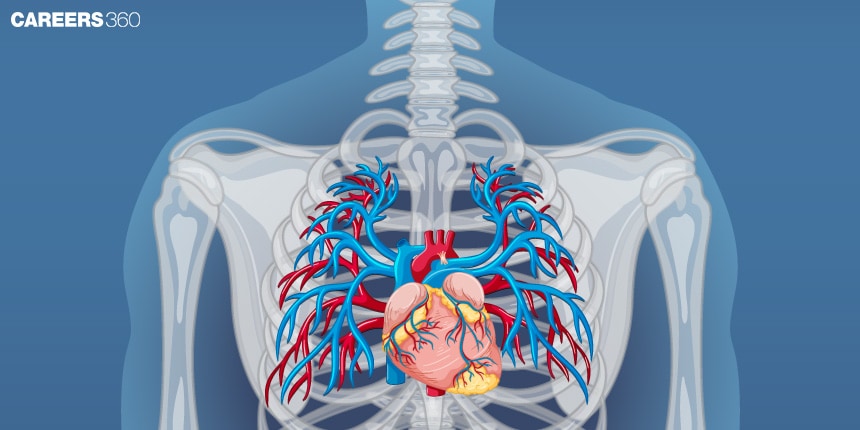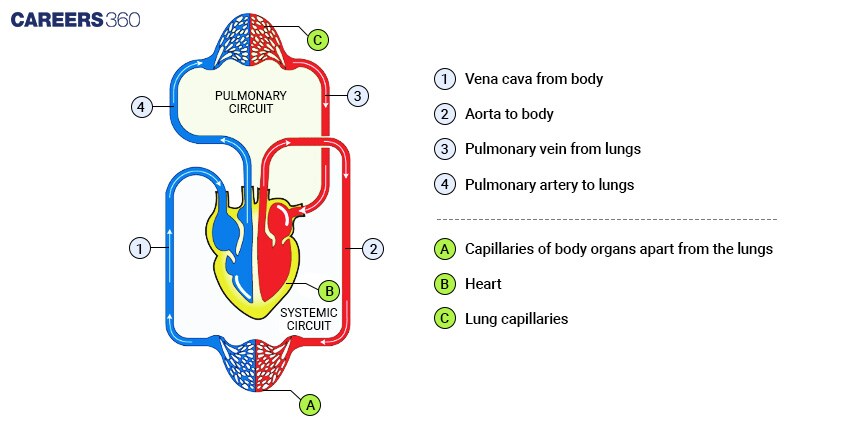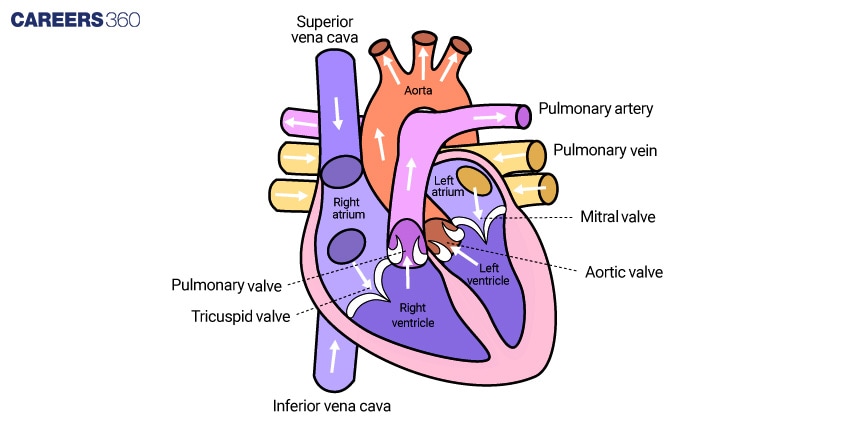Circulatory System: Definition, Function, Diagram
The circulatory system in human beings is a network used to transport blood, oxygen, nutrients, hormones, and waste products around the body. It is made up of the heart, blood vessels (arteries, veins, and capillaries), and blood. Combining these brings about proper functioning among organs and tissues. The circulatory system has a very important role in maintaining homeostasis of the body regulating temperature and helping in immunity. This important part of the Body Fluids And Circulation chapter in Biology.
This Story also Contains
- What is a Circulatory System?
- Components of the Circulatory System
- Structure of the Human Heart
- Diseases and Disorders of the Circulatory System
- Circulatory System in Other Organisms

What is a Circulatory System?
The circulatory or cardiovascular system belongs to the indispensable set of vessels through which blood, and therefore nutrients, gases, and metabolic waste products, is transported to and from all cells of the entire body. The circulatory system consists of the heart, blood vessels, and blood, which provide the various tissues with all the necessary nutrients and oxygen and get rid of carbon dioxide and metabolic waste products. The system is very important in supporting homeostasis and other functions of the body, such as temperature regulation and some immune responses.
Read more
Components of the Circulatory System
The primary components or parts of the circulatory system are the heart, blood vessels, and blood. All these play crucial roles in the overall functioning and efficiency of the circulatory system.
Heart
The details are given below:
Structure of the Heart
Four chambers: two atria (upper chambers) and two ventricles (lower chambers)
Valves: tricuspid, bicuspid (mitral), pulmonary, and aortic valves
Walls: endocardium (the inner layer), myocardium (the muscle layer), epicardium (the outer layer)
Function of Heart
A pump that provides a continuous circulation of blood throughout the body.
Blood pressure maintenance and blood flow
Carrying oxygen and nutrition, and carrying waste products to and from tissues, respectively.
Blood Vessels
Types: Arteries, Veins, Capillaries
The Pulmonary Arteries and Veins: The arteries convey deoxygenated blood, while the veins convey oxygenated blood
Capillaries: Microscopic blood vessels through which the exchange of nutrients and wastes between the blood and tissue fluid occurs
Structure and Function
Arteries: These vessels are thick-walled and elastic which is necessary due to the high blood pressure
Veins: The 'walls' of veins are much thinner, possessing valves to prevent backflow
Capillaries: Thin-walled (one cell thick) to assist in the process of diffusion for substances.
Blood
Composition: Plasma, Red Blood Cells, White Blood Cells, Platelets
Plasma: Liquid component consisting of water, proteins, hormones, and waste products.
Red Blood Cells (Erythrocytes): Contain haemoglobin, an oxygen-carrying pigment
White Blood Cells (Leukocytes): Part of the immune system that fight infection
Platelets (Thrombocytes): Involved in blood clotting and repair of wounds.
Functions of various components
Plasma: Transports nutrients, hormones, and waste products
Red Blood Cells: Transport oxygen from lungs to body tissues and back Carbon dioxide
White Blood Cells: Defense against disease-causing microorganisms provides immunity
Platelets: Involved in blood coagulation to arrest the loss of blood.
Human circulatory system

Structure of the Human Heart
The human heart is a strong and muscular organ whose major function is to pump blood in the vascular system. This unending task involves sending oxygenated blood to several tissues of the body while deoxygenated blood is sent to the lungs.
Anatomy of the Heart
Chambers: Atria and Ventricles
Two upper chambers of the heart receive blood (right atrium from the body, left atrium from the lungs)
Ventricles: Two lower chambers that eject the blood (right – to the lungs, left – to the body)
Valves: Tricuspid, Bicuspid, Pulmonary, Aortic
Tricuspid Valve: Found between the right atrium and right ventricle
Bicuspid (Mitral) Valve: Found between left atrium and left ventricle
Pulmonary Valve: Found between right ventricle and pulmonary artery
Aortic Valve: Found between the left ventricle and aorta.
Heartbeat and Cardiac Cycle
Phases of activities: systole; diastole
Systole: The contraction phase that results in blood being pumped out of the chambers.
Diastole: The phase of the heartbeat when the chambers fill with blood.
Electrical conduction system: SA Node, AV Node, Bundle of His, Purkinje Fibers.
SA Node: A small mass of muscle tissue in the wall of the right atrium that initiates the heartbeat, acting as the heart's natural pacemaker.
AV Node: Delays the impulse, allowing the atria to contract before the ventricles.
Bundle of His and Purkinje Fibers: The impulses reach the ventricles and result in their contraction.
Blood Circulation Pathways
The two most important pathways in the circulation of blood are systemic and pulmonary circulation. They both are very important in supplying oxygen and nutrients and removing waste.
Systemic Circulation
Path of Heart to Body and the Heart back.
Path: Left ventricle → Aorta → Arteries→ Capillaries→ Veins→ Right atrium
Functions
Supplies body tissues with oxygen and nutrients
Eliminates carbon dioxide and metabolic waste
Pulmonary Circulation
Pathway from Heart to Lungs and Back
Path: Right ventricle → Pulmonary artery→ Lungs →Pulmonary veins→ Left atrium
Functions
Oxygenates deoxygenated blood
Removes carbon dioxide from blood
Human Heart

Diseases and Disorders of the Circulatory System
Diseases and disorders of the circulatory system can have a major impact on health, so early diagnosis and treatment are important to prevent serious complications.
Hypertension (High Blood Pressure)
Signs and symptoms: Often has no symptoms but can lead to headaches, shortness of breath
Causes: Genetic, poor diet, lack of exercise, stress
Atherosclerosis
Symptoms: Chest pain, fatigue, shortness of breath
Causes: High cholesterol, Smoking, hypertension, diabetes
Heart Attack (Myocardial Infarction)
Symptoms: Chest pain, shortness of breath, sweating, nausea
Causes: Blockage of coronary arteries
Stroke
Symptoms: Sudden weakness, confusion, trouble speaking, vision problems.
Causes: Blockage or rupture of blood vessels in the brain.
Diagnostic Techniques
ECG (Electrocardiogram): Records the electrical activity of the heart
Echocardiogram: This is an ultrasonic test used to visualise the heart's structure and its functioning
Angiography: Blood vessels are imaged in this technique.
Treatment and Prevention
Medications: Blood pressure medicines cholesterol-lowering drugs and anticoagulants
Lifestyle Changes: Good diet, regular exercise, quitting smoking, stress management
Surgical Interventions: Angioplasty (a mechanical/wide-ranging intervention comprising inflating a balloon in a partially blocked artery, generally accompanied by the temporary insertion of a balloon or wire) and bypass surgery and placing a stent.
Circulatory System in Other Organisms
Different species have implemented circulatory systems in ways they have appropriate to their particular requirements and environments. In addition, circulatory systems also vary amongst other vertebrates.
Comparison with other Vertebrates
Fish: Single circulatory system, two-chambered heart
Amphibians: Double circulatory system, three-chambered heart: two atria, one ventricle.
Reptiles: Double circulatory system, three-chambered heart, partial septum in the ventricle.
Birds: Double circulatory system, four-chambered heart (as same as human beings).
Invertebrate Circulatory Systems
Examples: Insects, Molluscs
Insecta: Open circulatory system hemolymph instead of blood
Mollusca: Some open circulatory systems, but others like the cephalopods are closed.
Also Read:
Video Recommended on the Circulatory System
Frequently Asked Questions (FAQs)
The heart is in a position to pump blood by a combination of the rhythmic contraction it exerts through the cardiac cycle and electrical firing by the SA node, first into the contractile atria and ventricles.
Arteries carry blood away from the heart, veins return it, and capillaries enable the wafer-thin movement of oxygen, nutrients, and waste between blood and tissues.
Blood pressure is the force of blood circulation upon the walls of blood vessels. The control of the artery pressure differs in the regulation of blood pressure by controlling independent factors like cardiac output, blood, resistance, baroreceptors, and the renin-angiotensin system.
The disorders include among these common disorders, hypertension, atherosclerosis, heart attacks, and strokes. These have been diagnosed using ECG and angiography, and treated through medicinal, behavioural, and surgical means.
The circulatory system of the body conducts blood, nutrients, oxygen, carbon dioxide, and hormones. It entails the heart, blood, and blood vessels.